My itoigawa shimpaku
+6
Rob Kempinski
DaveP
Kev Bailey
bonsai monkey
fiona
Garykk
10 posters
Page 2 of 2
Page 2 of 2 •  1, 2
1, 2
 Re: My itoigawa shimpaku
Re: My itoigawa shimpaku
David,
Well put. I think you have encountered the essence of bonsai. By Higher or more advanced i didn't imply for it to being better. I meant it in your way: the art is the same, the level is different. Thanks for correcting my mistake.
The book you make reference to in quite amazing. Do you have the first or second version?
Kind regards,
Jose Luis
Well put. I think you have encountered the essence of bonsai. By Higher or more advanced i didn't imply for it to being better. I meant it in your way: the art is the same, the level is different. Thanks for correcting my mistake.
The book you make reference to in quite amazing. Do you have the first or second version?
Kind regards,
Jose Luis
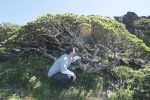
jrodriguez- Member
 Re: My itoigawa shimpaku
Re: My itoigawa shimpaku
I agree, these techniques can and are providing valuable resources for those interested in styling their bonsai. I also find the observations and conclusions about their natural occurrences valuable in providing a reference as to how and why they occur naturally, to be enlightening. Too often, a new technique becomes common place and over used just for their own sake without concern or thought as to how and why they happened in the first place. It is in this area where people have to understand the relationship between the tree, the dead wood and the environment to produce an image that is understandable and compelling. Without this approach the bonsai created tend to look contrived, made up of two separate elements (dead wood and living growth) instead of presenting a homogeneous image created by life, and not produced by man artificially.
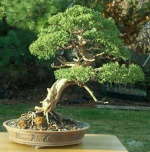
Vance Wood- Member
 Re: My itoigawa shimpaku
Re: My itoigawa shimpaku
jrodriguez wrote:David,
Well put. I think you have encountered the essence of bonsai. By Higher or more advanced i didn't imply for it to being better. I meant it in your way: the art is the same, the level is different. Thanks for correcting my mistake.
The book you make reference to in quite amazing. Do you have the first or second version?
Kind regards,
Jose Luis
Hi Jose Luis,
I have "Song of Life", the second version/volume. I wouldn't mind getting my hands on the first, "Writhing Dragon's Roar". Based on his description, I'm not sure if they're really different versions or more like two volumes. I'd love to tell first-hand.
As I sit here and thumb through it again, I'm taking what you said earlier about where the natural growth occurs and noticing things I'd never seen before. Thank you so very much for taking the time to add even more to what I've observed in these pictures!
Kindest~
-d
DaveP- Member
 Re: My itoigawa shimpaku
Re: My itoigawa shimpaku
Dave,
Mr. Wang is a true Lao Tze (teacher). The first volume is a hard cover book. I will see if i can get you a copy when i go to Taiwan in October. Try and scan a few pictures for the benefit of the forum viewers. Did you get the book from Yenchin Huang?
Later this week i will post some of my work on Satsuki Azalea. I am recreating images of rhododendron trees i saw in Yangming mountain in Taiwan. Budi Sulistyo saw he tree i am talking about last week and he bubbed in "pemphis style azalea".
Kind regards,
Jose Luis
Mr. Wang is a true Lao Tze (teacher). The first volume is a hard cover book. I will see if i can get you a copy when i go to Taiwan in October. Try and scan a few pictures for the benefit of the forum viewers. Did you get the book from Yenchin Huang?
Later this week i will post some of my work on Satsuki Azalea. I am recreating images of rhododendron trees i saw in Yangming mountain in Taiwan. Budi Sulistyo saw he tree i am talking about last week and he bubbed in "pemphis style azalea".
Kind regards,
Jose Luis

jrodriguez- Member
 Re: My itoigawa shimpaku
Re: My itoigawa shimpaku
jrodriguez wrote:Dave,
Mr. Wang is a true Lao Tze (teacher). The first volume is a hard cover book. I will see if i can get you a copy when i go to Taiwan in October. Try and scan a few pictures for the benefit of the forum viewers. Did you get the book from Yenchin Huang?
Later this week i will post some of my work on Satsuki Azalea. I am recreating images of rhododendron trees i saw in Yangming mountain in Taiwan. Budi Sulistyo saw he tree i am talking about last week and he bubbed in "pemphis style azalea".
Kind regards,
Jose Luis
Hi Jose Luis,
I did get my copy from Yenchin - if I recall, in September 2007. I'll toss a couple pages on the scanner shortly - great idea! I'm looking forward to seeing the images of your Azalea.
Kindest,
-d
DaveP- Member
 Re: My itoigawa shimpaku
Re: My itoigawa shimpaku
Dave,
Taroko National Park is quite stunning. By looking at the diferent trees that grow there, you can see the differences between the grwth patterns of rhododendron and conifers. Truly exceptional.
In order to see the trees you see in Mr. Wang's book, it is neccessary to obtain a hiking permit. Also, it takes about three days to get to the site.
Kind regards,
Jose Luis
Taroko National Park is quite stunning. By looking at the diferent trees that grow there, you can see the differences between the grwth patterns of rhododendron and conifers. Truly exceptional.
In order to see the trees you see in Mr. Wang's book, it is neccessary to obtain a hiking permit. Also, it takes about three days to get to the site.
Kind regards,
Jose Luis

jrodriguez- Member
 Re: My itoigawa shimpaku
Re: My itoigawa shimpaku
Here are three images scaned from Song of Life. Truly a study in the dichotomy between stunning beauty and utter brutality nature provides.
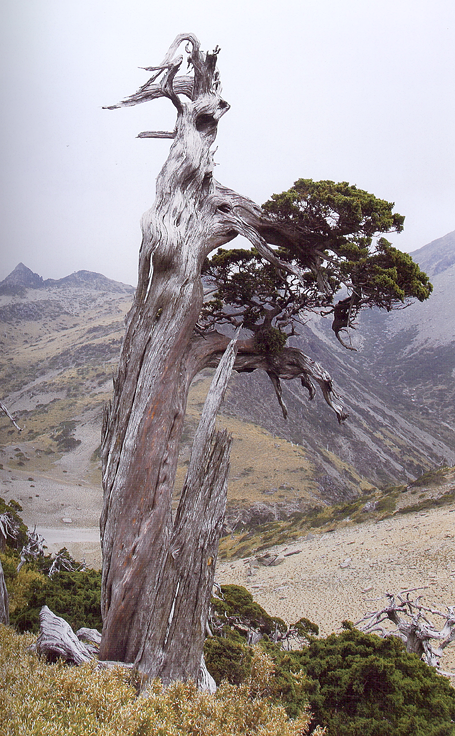
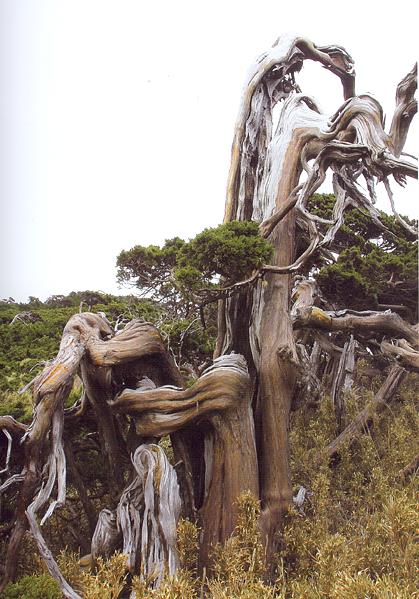
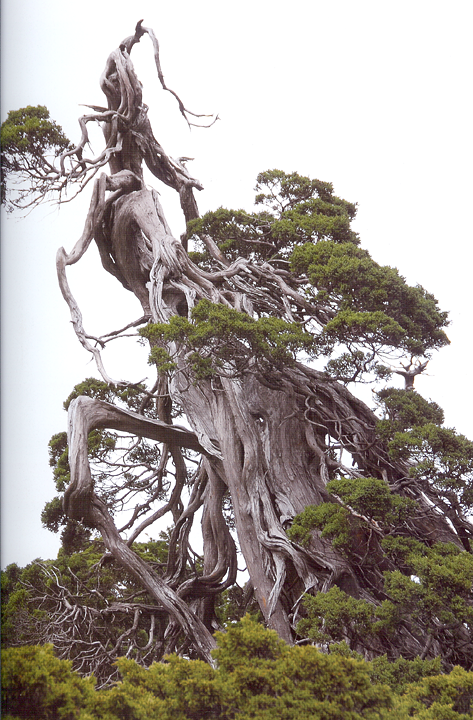
The book is ISBN 987-986-83386-1-6 I've not been able to find it online recently. Published in 2007, Softbound.
Kindest~
-d



The book is ISBN 987-986-83386-1-6 I've not been able to find it online recently. Published in 2007, Softbound.
Kindest~
-d
Last edited by DaveP on Tue Jun 30, 2009 6:21 pm; edited 1 time in total (Reason for editing : added publication info)
DaveP- Member
 Re: My itoigawa shimpaku
Re: My itoigawa shimpaku
Dave,
The yellowish grass you see below the Yushan Sang Po (junipers) is a type of dwarf bamboo. Also, there is a very fragrant species of rose that grows there.
See how the dead wood is always positioned in the opposite side of the green?
I will have copies of this book shortly.
Kind regards,
Jose Luis
The yellowish grass you see below the Yushan Sang Po (junipers) is a type of dwarf bamboo. Also, there is a very fragrant species of rose that grows there.
See how the dead wood is always positioned in the opposite side of the green?
I will have copies of this book shortly.
Kind regards,
Jose Luis

jrodriguez- Member
 Re: My itoigawa shimpaku
Re: My itoigawa shimpaku
Truly amazing. Sometimes we find images that are worth far more than 1000 words. There is so much to learn about how nature works. I would undoubtedly be overwhelmed if I were to see them in person!
Kindest~
-d
Kindest~
-d
DaveP- Member
 Re: My itoigawa shimpaku
Re: My itoigawa shimpaku
jrodriguez wrote:Dave,
The yellowish grass you see below the Yushan Sang Po (junipers) is a type of dwarf bamboo. Also, there is a very fragrant species of rose that grows there.
See how the dead wood is always positioned in the opposite side of the green?
I will have copies of this book shortly.
Kind regards,
Jose Luis
Thanks for the photos and the explanation.
Keep in mind that there is tremendous variation in nature and deadwood can be caused on certain trees for a variety of reasons not just wind. I saw Sabina junipers in Italy influenced by avalanches and rock slides and the contortions of the branches took all shapes. Coastal Buttonwood are influenced by tides, hurricanes and alligators - random patterns there. Lightning causes damage in random ways. So I guess the rule is there is no one rule.

Rob Kempinski- Member
 Re: My itoigawa shimpaku
Re: My itoigawa shimpaku
If I remember correctly the dead wood on a Needle Juniper in Japan is caused mostly by disease.

Vance Wood- Member
 Re: My itoigawa shimpaku
Re: My itoigawa shimpaku
[quote="Rob Kempinski"]
Buttonwood influenced by alligators? I am not biting that one. I suppose they got their name from button makers too? lols
jrodriguez wrote:Dave,
Thanks for the photos and the explanation.
Coastal Buttonwood are influenced by tides, hurricanes and alligators - random patterns there. Lightning causes damage in random ways. So I guess the rule is there is no one rule.
Buttonwood influenced by alligators? I am not biting that one. I suppose they got their name from button makers too? lols
Garykk- Member
Page 2 of 2 •  1, 2
1, 2
 Similar topics
Similar topics» Shimpaku "Itoigawa"
» second style itoigawa shimpaku
» before, during, after - first style itoigawa shimpaku
» Twisted Itoigawa Shimpaku Progression
» Itoigawa Shimpaku 6 years in training
» second style itoigawa shimpaku
» before, during, after - first style itoigawa shimpaku
» Twisted Itoigawa Shimpaku Progression
» Itoigawa Shimpaku 6 years in training
Page 2 of 2
Permissions in this forum:
You cannot reply to topics in this forum






